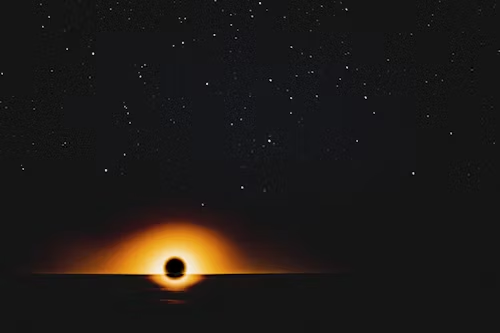
The Event Horizon Telescope (EHT) collaboration, which has been active since 2017, has released the first polarized light image of the of the supermassive black hole Sagittarius A* (Sgr A*), located at the heart of our galaxy. This allowed astronomers to measure polarization, an indicator of the presence of strong and organized magnetic fields spiraling from the edge of black hole. Moreover, the image revealed that the magnetic field structure is strikingly similar to that of the black hole M87*, located at the centre of the galaxy as well, suggesting that strong magnetic fields may be common to all black holes. This similarity also hints toward a hidden jet of matter located inside Sgr A*, just like M87*.
Having images of both supermassive black holes in polarized light is a great result because it provides new ways to compare and contrast black holes of different sizes and masses. As technology improves, the images are likely to reveal even more secrets of black holes and their similarities or differences.
“The fact that the magnetic field structure of M87* is so similar to that of Sgr A* is very meaningful because it suggests that the physical processes that govern how a black hole feeds and launches a jet might be universal among supermassive black holes, despite differences in mass, size, and surrounding environment. This result allows us to refine our theoretical models and simulations, improving our understanding of how matter is influenced near the event horizon of a black hole,” said Mariafelicia De Laurentis, professor at the University ‘Federico II’ of Naples and researcher at the National institute of Nuclear Physics (INFN).
Kazi Rygl, researcher at the National Institute of Astrophysics (INAF) in Bologna, added that thanks to polarized light, it will be possible to learn more about these aspects of the nature of the black hole, such as the properties of the gas, and mechanisms that take place as a black hole feeds.
The EHT scientific collaboration is scheduled to observe Sgr A* again in April 2024. Each year, the images improve as the EHT incorporates new telescopes, larger bandwidth, and new observing frequencies. Planned expansions for the next decade will enable high-fidelity movies of Sgr A*. This increased and detailed sensitivity could reveal a jet of matter still hidden today, and allows scientists to observe similar polarization features in other black holes. Moreover, extending the EHT into space, with contribution of satellite telescopes, will provide sharper images of black holes than ever before.
To learn more, see also:
- Black hole, Event Horizon Telescope (EHT) released new images of M87*
- The Astrophysical Journal Letters article “First Sagittarius A* Event Horizon Telescope Results. VII. Polarization of the Ring”
- The Astrophysical Journal Letters article “First Sagittarius A* Event Horizon Telescope Results. VIII.: Physical interpretation of the polarized ring”
- Eso Press release

